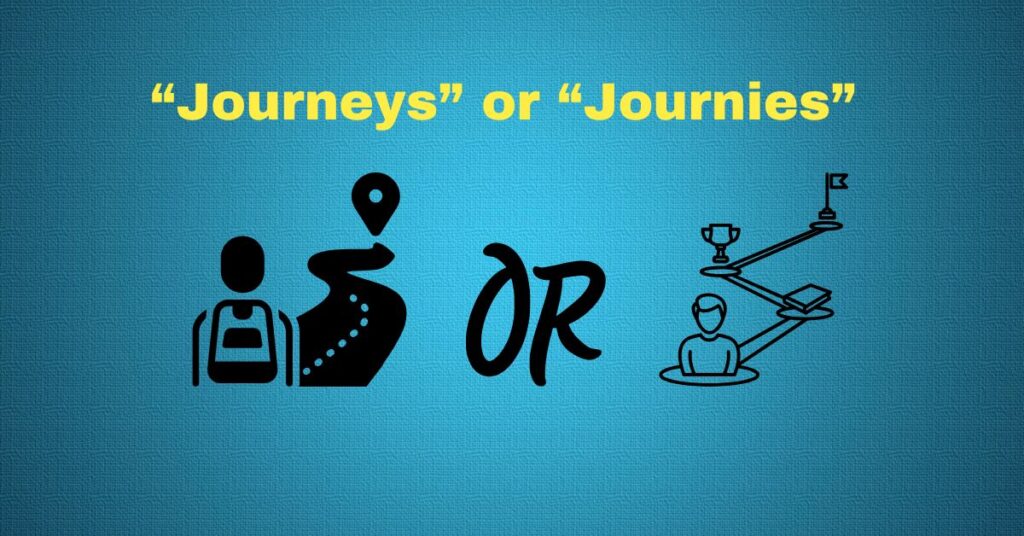If you’ve ever found yourself second-guessing whether to use “journeys” or “journies” when talking about multiple trips or experiences, you’re not alone. English can be confusing, especially when it comes to forming plurals. In this article, we’ll clear up the confusion surrounding the plural form of “journey” and explain why “journeys” is the correct choice. Whether you’re a native English speaker or a learner, understanding the rules behind this pluralization will help you communicate more confidently. Let’s dive in and uncover the truth about “journeys” vs. “journies.”
Definition
Journey refers to the act of traveling from one place to another, usually over a considerable distance. It can also symbolize a personal process of change or growth, often related to life’s milestones. When we speak of multiple travels or significant life experiences, the plural form of “journey” is “journeys.”
- Singular: Journey
- Plural: Journeys
Meaning & Explanation
Understanding the pluralization rule here is key. In English, most nouns that end in a consonant + “y” (like “journey”) follow a simple rule to form their plural: replace the “y” with “ies.”
- Singular: Journey
- Plural: Journeys
This pattern is seen in other common words:
- City → Cities
- Party → Parties
- Family → Families
In contrast, words ending in a vowel + “y,” such as “key” or “toy,” only add an “s” for the plural form (keys, toys).
So, with “journey,” the rule is clear. The correct plural form is “journeys,” not “journies.”
Examples & Usage
To make sure you’re using the plural form of “journey” correctly, here are some examples of how “journeys” can be used in sentences:
- “They embarked on several unforgettable journeys across the world.”
- This sentence refers to multiple travel experiences, each one significant in its own way.
- “His journeys through the deserts of Africa were physically and mentally demanding.”
- Here, “journeys” refers to multiple experiences of travel in the same general area, but each one is distinct.
- “Throughout their many journeys, they learned valuable lessons about culture and history.”
- In this case, “journeys” highlights various travels that led to personal growth and knowledge.
- “The book chronicles the author’s journeys through unfamiliar lands and foreign cultures.”
- The plural “journeys” refers to the different travels or explorations described in the book.
- “Her journey to success was long and filled with obstacles, but each step was worth it.”
- This sentence uses the singular “journey” in a metaphorical sense, representing a long process of achieving a goal.
As shown, “journeys” refers to a series of travels or experiences. These can be physical trips or metaphorical transitions in one’s life.
Types & Categories
Although the plural of “journey” is always “journeys,” the word can apply to a variety of contexts. Here’s a breakdown of the different types of journeys you might refer to:
| Type of Journey | Description | Example |
| Physical Journeys | Actual travel from one location to another. | “Their journeys took them to every corner of the globe.” |
| Emotional Journeys | Personal growth or emotional transformations. | “Her emotional journey through grief helped her heal.” |
| Spiritual Journeys | The pursuit of self-discovery, enlightenment, or religious growth. | “Many take spiritual journeys to find inner peace.” |
| Historical Journeys | Notable travel experiences from a historical perspective. | “The journeys of explorers like Magellan shaped our world.” |
| Metaphorical Journeys | Symbolic journeys representing life experiences or challenges. | “The journey of writing this book has been filled with highs and lows.” |
These categories show how “journeys” can refer to both literal and figurative travels, helping to express a wide range of experiences.
Related Words & Synonyms
While “journeys” is the standard plural form, there are several synonyms and related words that convey similar meanings depending on context. Here’s a list of related terms:
- Expeditions
- Adventures
- Trips
- Excursions
- Travels
- Voyages
- Trek
- Odyssey (often for a long, epic journey)
- Pilgrimage (typically a journey with spiritual significance)
Each of these words adds a different layer to the idea of a journey, so choose the one that best fits your context.
FAQ Section
1. Is “journies” a correct plural form?
No, “journies” is incorrect. The proper plural form of “journey” is “journeys.” This follows the standard English rule for pluralizing words that end in a consonant + “y,” where you replace the “y” with “ies.”
2. When should I use the word “journeys”?
Use “journeys” when you’re referring to multiple instances of travel or meaningful life experiences. Whether you’re talking about actual trips or metaphorical journeys, this plural form is appropriate.
3. Can “journeys” refer to more than just physical travel?
Yes, absolutely! “Journeys” can refer to emotional, spiritual, or intellectual experiences. For instance, you might describe a personal transformation as a “journey” or talk about a “spiritual journey” toward self-discovery.
4. Why is “journeys” the plural form and not “journies”?
The plural form of words like “journey” that end in a consonant + “y” follows the general English rule of replacing the “y” with “ies.” Hence, “journeys” is the correct plural.
5. Are there exceptions to this rule?
There are a few exceptions in English where irregular plural forms exist (e.g., “child” becomes “children” and “foot” becomes “feet”), but “journey” follows the regular pluralization rule.
Conclusion
In conclusion, the correct plural form of “journey” is “journeys,” not “journies.” This follows a simple, consistent rule in English: when a word ends in a consonant + “y,” replace the “y” with “ies” to form the plural. Whether you’re talking about physical travel or metaphorical experiences, the plural form “journeys” is the way to go. By mastering this rule, you’ll enhance both your writing and speaking skills, avoiding common errors and sounding more confident in your use of English.
Since vs Sense When to Use Each Word






